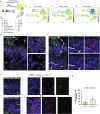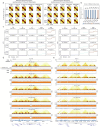Temporally distinct 3D multi-omic dynamics in the developing human brain
- PMID: 39385032
- PMCID: PMC11560841
- DOI: 10.1038/s41586-024-08030-7
Temporally distinct 3D multi-omic dynamics in the developing human brain
Abstract
The human hippocampus and prefrontal cortex play critical roles in learning and cognition1,2, yet the dynamic molecular characteristics of their development remain enigmatic. Here we investigated the epigenomic and three-dimensional chromatin conformational reorganization during the development of the hippocampus and prefrontal cortex, using more than 53,000 joint single-nucleus profiles of chromatin conformation and DNA methylation generated by single-nucleus methyl-3C sequencing (snm3C-seq3)3. The remodelling of DNA methylation is temporally separated from chromatin conformation dynamics. Using single-cell profiling and multimodal single-molecule imaging approaches, we have found that short-range chromatin interactions are enriched in neurons, whereas long-range interactions are enriched in glial cells and non-brain tissues. We reconstructed the regulatory programs of cell-type development and differentiation, finding putatively causal common variants for schizophrenia strongly overlapping with chromatin loop-connected, cell-type-specific regulatory regions. Our data provide multimodal resources for studying gene regulatory dynamics in brain development and demonstrate that single-cell three-dimensional multi-omics is a powerful approach for dissecting neuropsychiatric risk loci.
© 2024. The Author(s).
Conflict of interest statement
Figures















References
-
- Molyneaux, B. J., Arlotta, P., Menezes, J. R. L. & Macklis, J. D. Neuronal subtype specification in the cerebral cortex. Nat. Rev. Neurosci.8, 427–437 (2007). - PubMed
MeSH terms
Substances
Grants and funding
LinkOut - more resources
Full Text Sources
Molecular Biology Databases

